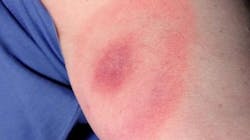Mistrust, unclear test results, differing guidance all part of Lyme puzzle
Every year, 300,000 Americans are diagnosed as having Lyme disease, caused by Borrelia burgdorferi bacteria and transmitted by a bite from blacklegged ticks. The number of cases has risen each year since the disease was first identified in the mid-1970s in Lyme, Connecticut.
But unlike other diseases, time has not provided crystal clarity in diagnosing the disease nor certainty in treating it. And Lyme has been wreathed in suspicions by patients and an at-times confusing clinical course.
The University of Minnesota Center for Infectious Disease Research and Policy (CIDRAP) reports that this summer the conversation surrounding Lyme reached a new boiling point when a decades-old conspiracy theory—that Lyme was created by the U.S. military as a bioweapon—resurfaced in a new book, “Bitten” which is authored by a women who contracted the disease. In July, Rep Christopher H. Smith, R-N.J., asked Congress to investigate the Department of Defense to see if Lyme disease is the result of a US military experiments.
Though the theory has been widely disputed by experts who have genetic evidence the bacteria predates that claim, its mere suggestion hints at the contentiousness that surrounds Lyme.
Sam R. Telford III, PhD, professor of vector-borne infections and public health at Tufts University, has published several op-eds this summer detailing, in careful terms, just how and why the Lyme as bioweapon conspiracy is fiction.
"The idea is just not tenable," said Telford, who first heard this rumor in the 1980s as a graduate student. "We have papers of population genetic analysis that show the bacteria date back thousands of years."
Moreover, Telford told CIDRAP News, Lyme would be a weak choice as a bioweapon, as it doesn't kill, and the U.S. military also created DEET and permethrin-treated clothing—the best prevention against ticks.
Elizabeth Maloney, MD, president of the nonprofit Partnership for Tick-borne Diseases Education, said she does not believe the conspiracy, but understands why so many patients do.
"When you hear the stories of some of the ways patients with Lyme have been treated, it's no surprise they move towards conspiracy therapies," Maloney said. "When we disrespect patients, this is what happens."
In about 70 percent to 80 percent of Lyme cases, according to the Centers of Disease Control and Prevention (CDC), patients will have a bull's-eye rash known as erythema migrans (EM) and flu-like symptoms in the weeks following a tick bite.
If a clinician sees a rash and the patient notes likely exposure to ticks (through a camping trip, for example) a 2- to 4-week course of doxycycline is prescribed to kill the B burgdorferi bacteria. In patients without a rash, Bell's palsy or a sudden onset of arthritis can point to Lyme, which is confirmed by testing. Those patients also get antibiotics.
For most, this treatment works. But anywhere from 10 percent to 20 percent will experience post-treatment Lyme disease syndrome (PTLDS) at least 6 months after treatment, a set of neurologic and pain-related symptoms that confound providers, some of whom believe the bacteria are still causing an infection, and others who believe that the tick bite triggered an immune response.
Still others say the patient isn't experiencing Lyme at all, but a new and as-yet undiagnosed illness unrelated to Lyme.
